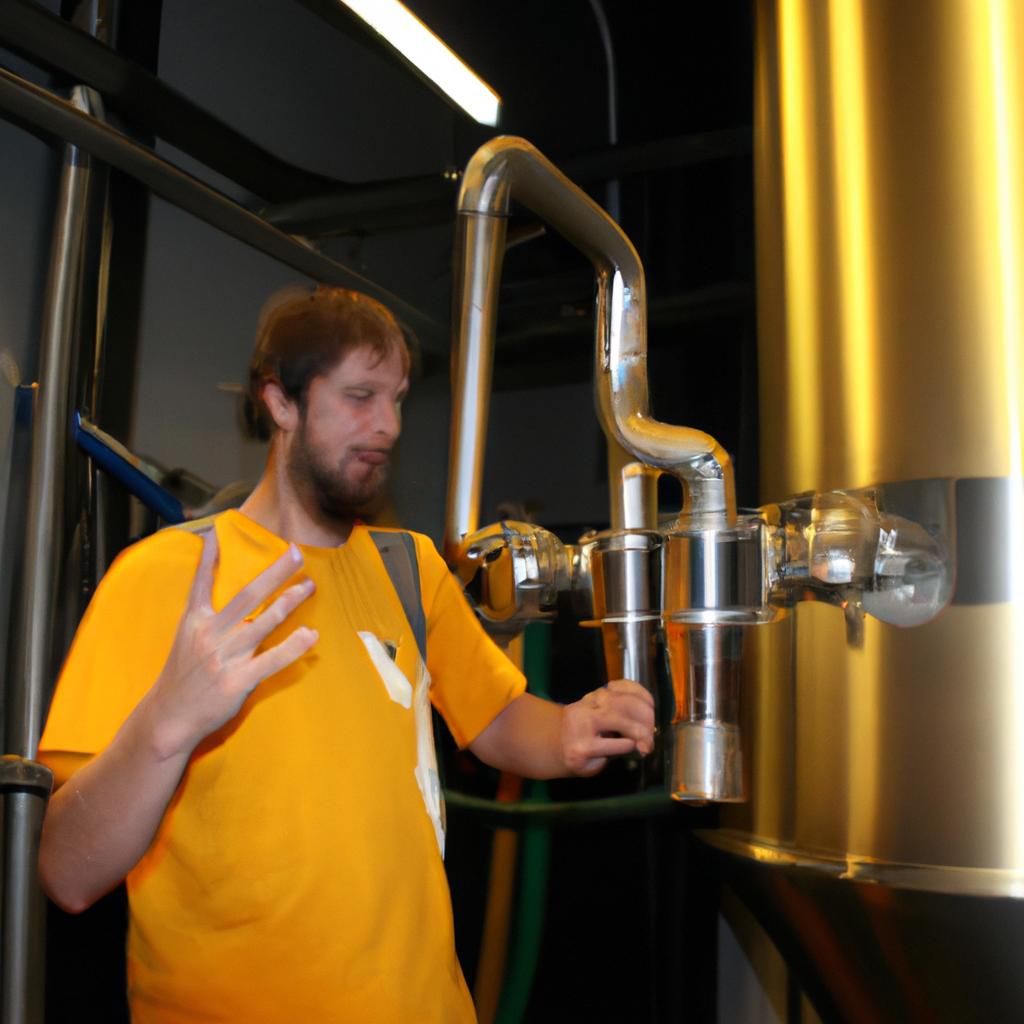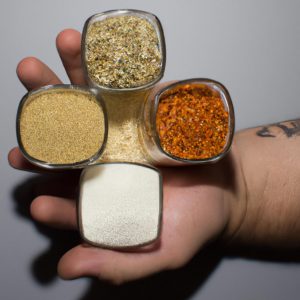Brewing Process: Beer Styles Explained

The brewing process is a fascinating and intricate craft that has been practiced for centuries, resulting in a wide variety of beer styles. Understanding the different beer styles and their characteristics can enhance one’s appreciation for the intricacies of this ancient art form. For instance, let us consider the case study of an avid beer enthusiast who walks into a brewery and finds themselves overwhelmed by the array of options available. By delving deeper into the brewing process and exploring various beer styles, we can gain insight into how different ingredients, techniques, and traditions contribute to the distinct flavors and aromas found in each unique brew.
In order to fully appreciate the complexities of beer styles, it is essential to understand the fundamental steps involved in the brewing process. The first step begins with malting grains such as barley or wheat, where they are soaked in water to initiate germination. This triggers enzymes within the grains to break down complex carbohydrates into simpler sugars that yeast can ferment. After malting, the grains are dried and crushed before being mixed with hot water during mashing. This process extracts additional starches from the grains which will serve as food sources for yeast during fermentation. Following mashing, lautering occurs where liquid wort (the sugary solution) is separated from solid grain particles. This liquid wort is then boiled, typically for about an hour, during which hops are added at different intervals to contribute bitterness, flavor, and aroma to the beer. After boiling, the wort is rapidly cooled to a temperature suitable for yeast fermentation.
Once the wort is cooled, it is transferred to a fermentation vessel where yeast is added. Yeast plays a crucial role in the brewing process as it consumes the sugars in the wort and produces alcohol and carbon dioxide as byproducts. The type of yeast used can greatly influence the final flavor profile of the beer.
During fermentation, which can last anywhere from a few days to several weeks depending on the style, the beer undergoes chemical changes as yeast converts sugars into alcohol and carbon dioxide. After fermentation is complete, some beers may undergo additional aging or conditioning processes such as lagering or barrel-aging to further develop flavors and smooth out any harsh characteristics.
With this understanding of the brewing process, we can now explore various beer styles and their unique characteristics. There are numerous beer styles categorized based on factors such as color (e.g., pale ale vs. stout), strength (e.g., session beers vs. imperial beers), fermentation method (e.g., lagers vs. ales), and regional traditions (e.g., Belgian styles vs. German styles).
Each beer style has its own set of ingredients, techniques, and traditions that contribute to its distinct taste profile. For example, an IPA (India Pale Ale) is known for its hop-forward character with noticeable bitterness and citrusy or piney flavors. On the other hand, a wheat beer tends to be light-bodied with fruity esters and spicy notes from special wheat yeast strains.
By exploring different beer styles and their characteristics, one can broaden their palate and appreciation for diverse flavors within the world of craft beer. Whether you prefer a crisp pilsner on a hot summer day or a rich and complex barrel-aged stout, understanding the brewing process and the nuances of various beer styles can enhance your enjoyment and make each beer-drinking experience more meaningful.
Malting: The first step in the brewing process where grains are soaked, germinated, and dried to produce malt.
Malting: The first step in the brewing process where grains are soaked, germinated, and dried to produce malt.
Imagine a world without beer. It’s difficult, isn’t it? Beer has been an integral part of human civilization for centuries, enjoyed by people from all walks of life. Have you ever wondered how this beloved beverage is made? Well, let’s dive into the fascinating journey of beer production starting with malting – the crucial first step in the brewing process.
Malting, as mentioned earlier, involves soaking grains such as barley or wheat in water until they begin to sprout. This controlled germination process activates enzymes within the grain that convert complex starches into simpler sugars. Once sprouted, the grains are carefully dried using hot air while being constantly turned to prevent them from sticking together. This careful drying halts further enzymatic activity and preserves the flavor and aroma compounds present in the malt.
To better understand malting, let’s explore its significance through a hypothetical case study:
- Imagine a brewer named Alex who wants to create a rich and flavorful stout beer.
- To achieve this, Alex selects dark roasted barley during malting, which imparts intense flavors of coffee and chocolate to the final product.
- Additionally, during drying, Alex ensures that low temperatures are maintained to preserve delicate aromas inherent in specialty malts.
Now that we have examined the basic concept behind malting, let’s delve deeper into its importance by exploring some key factors:
- Flavor: Different types of malt provide distinct flavors ranging from biscuit-like sweetness to caramel notes.
- Color: Malts contribute varying shades to beers; lighter malts result in pale golden hues while darker ones yield deep amber or even black colors.
- Body: Malt selection affects mouthfeel; certain malts add body and fullness to beers.
- Enzymes: The enzymes activated during malting play a crucial role in breaking down starches into fermentable sugars, fueling the fermentation process.
To highlight these factors further, let’s consider the following table showcasing common malt types and their characteristics:
| Malt Type | Flavor | Color | Body |
|---|---|---|---|
| Pale Malt | Subtle sweetness | Light golden | Light-bodied |
| Munich Malt | Bready, malty | Amber | Medium-bodied |
| Crystal Malt | Caramel-like | Deep amber | Full-bodied |
| Roasted Malt | Coffee, chocolate | Black | Full-bodied |
By understanding the nuances of malting, brewers can carefully select and combine various malt types to craft beers with unique flavors, colors, and textures. Now that we have explored this important aspect of brewing, our journey continues to the next section—Mashing: The process of mixing malt with hot water to convert starches into fermentable sugars.
[Transition sentence] In mashing, brewers take advantage of the malt produced during the malting stage to extract essential sugars needed for fermentation.
Mashing: The process of mixing malt with hot water to convert starches into fermentable sugars.
From Malting to Mashing: Transforming Grains into Fermentable Sugars
Imagine a world without beer. A cold, refreshing beverage enjoyed by millions around the globe would be absent from our lives. The brewing process plays an essential role in bringing this beloved drink to fruition. In the previous section, we explored how malting prepares grains for brewing. Now, let us delve into the next step of this intricate process: mashing.
Mashing is a pivotal stage where malted grains are combined with hot water to convert starches into fermentable sugars. This enzymatic conversion occurs due to the action of enzymes present in the malt. For instance, alpha-amylase and beta-amylase break down complex carbohydrates into simpler sugar molecules, such as glucose and maltose, which yeast can later consume during fermentation.
During mashing, several crucial factors influence the outcome of the final brew:
- Temperature: Controlling temperature throughout mashing is vital to activate specific enzymes responsible for starch conversion.
- pH Level: Maintaining an appropriate pH level helps optimize enzyme activity and ensure efficient sugar extraction.
- Water-to-grain Ratio: Finding the right balance between water and grain enables proper hydration and facilitates enzymatic reactions.
- Mash Time: Allowing sufficient time for enzymatic activity guarantees complete starch conversion and maximizes sugar yield.
To better illustrate these variables’ impact on brewing outcomes, consider the following scenario:
| Variables | Optimal Range | Scenario A | Scenario B |
|---|---|---|---|
| Temperature | 148°F – 158°F (64°C -70°C) | 155°F (68°C) | 145°F(63°C) |
| pH Level | 5.2 – 5.6 | 5.0 | 5.8 |
| Water-to-grain ratio | 1.25 – 1.5 | 1.2 | 1.6 |
| Mash Time | 60 minutes | 45 minutes | 75 minutes |
In Scenario A, where the temperature is within the optimal range and other variables are well-maintained, the brewing process progresses smoothly, resulting in a desirable beer profile. In contrast, Scenario B’s suboptimal conditions may lead to an inferior brew with potential off-flavors or incomplete fermentation.
As mashing concludes, our journey through the brewing process continues with boiling: The wort is boiled, and hops are added to impart bitterness, flavor, and aroma. Let us explore this next step further and uncover its role in shaping the characteristics of your favorite beers.
Boiling: The wort is boiled and hops are added to impart bitterness, flavor, and aroma.
From the mashing process, we move on to the next crucial step in beer brewing: boiling. Boiling is a fundamental stage where the wort, which is the liquid extracted from mashing, undergoes significant transformations and gains its characteristic flavors.
To illustrate the importance of boiling, let’s consider an example involving a popular beer style – India Pale Ale (IPA). During this step, hops are added to the boiling wort, imparting bitterness, flavor, and aroma that define an IPA’s unique profile. The length of time hops are boiled can vary depending on desired characteristics; for instance, a longer boil may result in more pronounced bitterness.
Boiling serves several vital purposes in the brewing process:
- Sterilization: The high temperatures achieved during boiling kill off any unwanted microorganisms present in the wort.
- Enzyme deactivation: Boiling helps halt enzymatic activity initiated during mashing by denaturing enzymes responsible for converting starches into sugars.
- Concentration: As water evaporates during boiling, it increases the concentration of sugars and other compounds in the wort.
- Hops utilization: Boiling facilitates extraction of alpha acids from hops, contributing bitterness and aromas to the final product.
Consider this table showcasing different hopping techniques used during boiling:
| Technique | Description |
|---|---|
| Bittering | Long boil times extract maximum bitterness with minimal hop aroma |
| Aroma | Late addition or whirlpool additions maximize hop aroma without much |
| additional bitterness | |
| Dry Hopping | Adding hops after fermentation enhances aromatic qualities |
| Hop Bursting | Utilizing large amounts of late-addition hops for intense hop character |
Nowadays, modern brewers also experiment with unconventional ingredients like fruit peels or spices added at various stages during boiling to create innovative flavors that push traditional boundaries.
As we conclude the discussion on boiling, it becomes evident that this step plays a crucial role in shaping beer flavors and characteristics. The boiled wort is now ready for its next transformation: fermentation. In this process, yeast is added to the cooled wort, converting sugars into alcohol and carbon dioxide – a topic we will explore further.
Fermentation: Yeast is added to the cooled wort, converting sugars into alcohol and carbon dioxide.
Transitioning from the boiling process, we now move on to fermentation. This crucial step in the brewing process involves adding yeast to the cooled wort, initiating a transformation that results in the creation of alcohol and carbon dioxide. To better understand this process, let’s consider an example: imagine a brewery crafting their signature IPA (India Pale Ale). After boiling the wort and imparting bitterness, flavor, and aroma with hops, they transfer it to a fermenter.
During fermentation, several key changes occur within the wort. The addition of yeast kickstarts a biochemical reaction known as anaerobic respiration, where sugars present in the wort are converted into alcohol and carbon dioxide. Here are some important points about fermentation:
- Temperature control is critical: Different yeasts have specific temperature requirements for optimal performance. It is essential to carefully monitor and regulate temperatures during fermentation to ensure desired flavors and aromas.
- Fermentation time varies: Depending on factors such as yeast strain, recipe complexity, and target beer style, fermentation can take anywhere from a few days to several weeks.
- Secondary fermentation may be necessary: Some beers undergo secondary fermentation after primary fermentation is complete. This additional stage allows further development of flavors and clarification of the beer.
- Carbonation options: While many beers naturally carbonate during fermentation by trapping carbon dioxide produced by yeast activity, others require artificial carbonation through forced carbonation methods.
To illustrate these concepts further, here’s an overview table showcasing different types of yeast strains commonly used in brewing:
| Yeast Strain | Characteristics |
|---|---|
| Saccharomyces | Most common brewers’ yeast |
| Brettanomyces | Adds funkiness or sourness |
| Lactobacillus | Produces lactic acid for tartness |
| Pediococcus | Contributes sour flavors |
As fermentation comes to an end, the wort has transformed into beer. However, our brewing journey is not yet complete. In the subsequent section about conditioning, we will explore how this vital step further enhances flavors and carbonation in the finished product.
With fermentation complete, it’s time to delve into the next stage of the brewing process – conditioning. After all, creating a well-rounded and flavorful beer involves more than just fermentation alone.
Conditioning: After fermentation, the beer is conditioned to develop flavors and carbonation.
From fermentation, the beer undergoes a process known as conditioning. During this stage, the beer is allowed to mature and develop its unique flavors and carbonation levels. Conditioning plays a crucial role in enhancing the overall quality of the final product.
Imagine a scenario where a brewery has just finished fermenting their latest batch of pale ale. The brewers understand that for their beer to reach its full potential, it needs to go through a period of conditioning. They carefully transfer the fermented beer into conditioning vessels, such as tanks or barrels, ensuring minimal oxygen exposure during the transfer process.
During conditioning, several key factors contribute to the development of flavors and carbonation in the beer:
- Temperature control: Maintaining specific temperature ranges allows for proper maturation of flavors without compromising on freshness.
- Time: The duration of conditioning varies depending on the style of beer being produced but can range from weeks to months.
- Carbonation method: Brewers may choose between natural carbonation, where priming sugar is added before packaging, or forced carbonation using CO2 injection.
- Clarification: Some beers benefit from additional clarification techniques like fining agents or filtering to achieve desired clarity.
To illustrate these factors further, consider the following table showcasing different styles of beer and their recommended time and temperature conditions for optimal conditioning:
| Beer Style | Recommended Condition Time | Recommended Temperature Range |
|---|---|---|
| Pale Ale | 2 – 4 weeks | 50°F – 55°F (10°C – 13°C) |
| Stout | 1 – 3 months | 55°F – 60°F (13°C – 16°C) |
| Wheat Beer | 2 – 6 weeks | 40°F – 45°F (4°C – 7°C) |
| Lager | 4 -12 weeks | 35°F – 45°F (2°C – 7°C) |
As the conditioning period concludes, the beer undergoes a transformation. Flavors become more balanced and refined while carbonation levels reach their desired effervescence. The result is a well-rounded, enjoyable brew ready for packaging.
Transitioning into the subsequent section about “Packaging: The final step involves packaging the beer, whether in bottles, cans, or kegs,” brewers carefully monitor the conditioning process to ensure that their beers are at their prime before moving on to this next crucial stage of production.
Packaging: The final step involves packaging the beer, whether in bottles, cans, or kegs.
Once the conditioning process is complete, it is time to move on to the next crucial step in brewing – packaging. By carefully selecting the appropriate packaging method, brewers ensure that their crafted beers reach consumers in optimal condition while preserving their distinct characteristics. Let’s explore the various aspects involved in this final stage of the brewing process.
Packaging Methods:
There are several options available for packaging beer. Each method offers its own set of advantages and considerations, allowing brewers to choose what works best for their specific needs. Here are some common packaging methods used within the industry:
- Bottles: Often made of glass, bottles provide an excellent barrier against light and oxygen exposure.
- Cans: Aluminum cans have gained popularity due to their superior protection against both light and oxygen.
- Kegs: Ideal for commercial use or large gatherings, kegs allow for efficient storage and dispensing of larger quantities of beer.
Table – Pros and Cons of Different Packaging Methods:
| Bottles | Cans | Kegs | |
|---|---|---|---|
| Light | Good | Excellent | Minimal |
| Oxygen | Good | Excellent | Minimal |
| Portability | Average | Good | Limited |
| Recyclability | Varies | High | Reusable |
When choosing a packaging method, consider these factors:
- Environmental Impact
- Quality Preservation
- Consumer Convenience
- Brand Image Enhancement
Ultimately, breweries must strike a balance between cost-effectiveness, quality preservation, environmental impact, and consumer preferences when deciding how to package their beer. By carefully considering the pros and cons of each method, brewers can ensure that their product reaches consumers in its best possible form.
In summary, packaging plays a crucial role in the brewing process, as it not only protects the beer but also influences consumer perception and overall brand image. Brewers must take into account various factors when selecting a packaging method that aligns with their goals and values. With careful consideration and attention to detail, breweries can deliver an exceptional drinking experience to enthusiasts worldwide.



